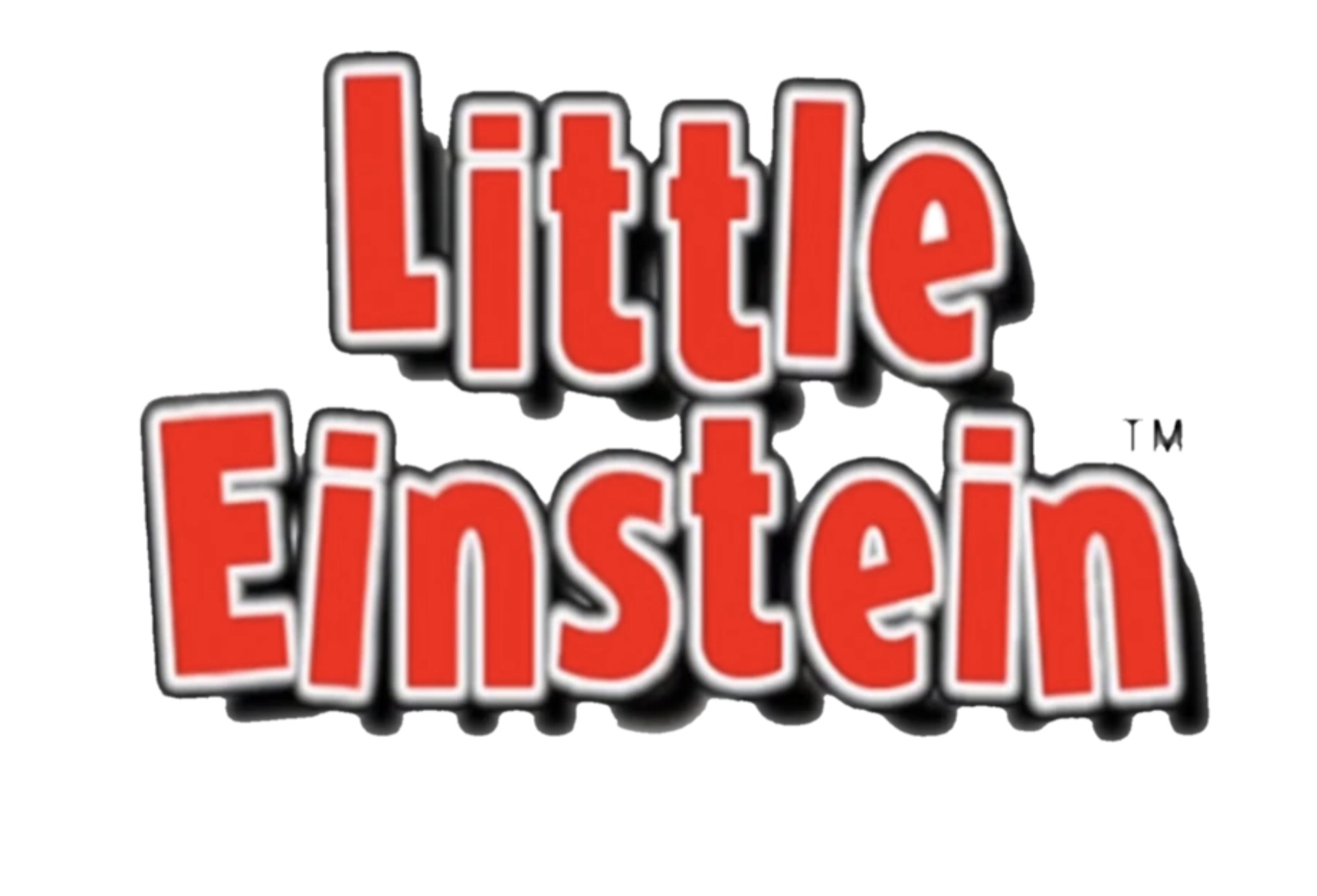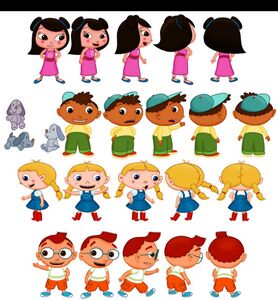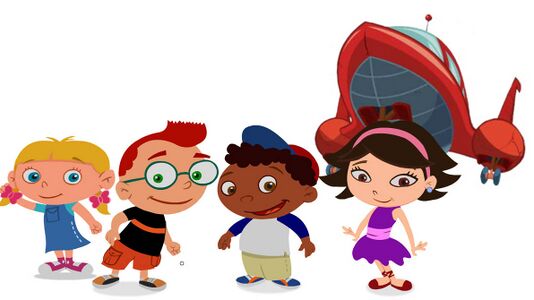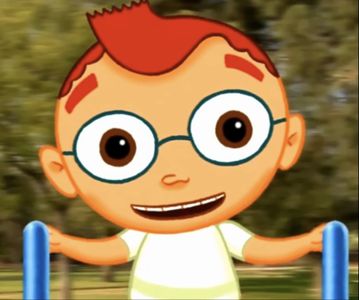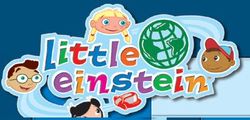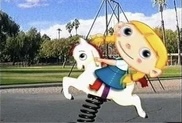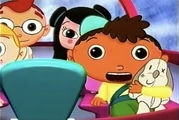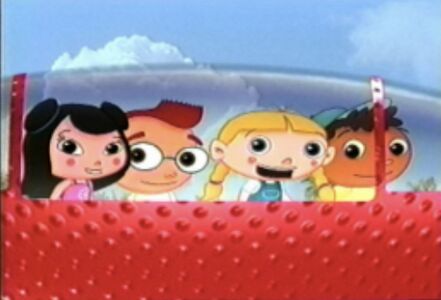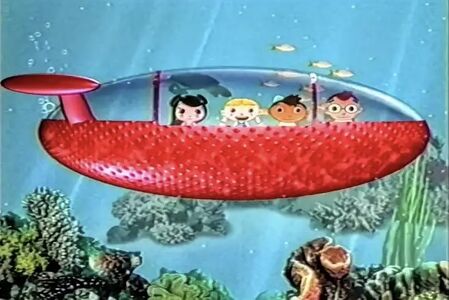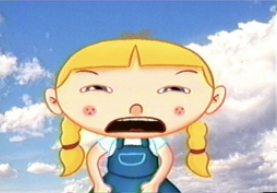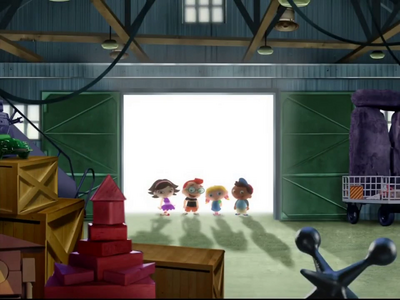Little Einstein (partially found pitch pilots of Playhouse Disney animated series; 2003-2004)
Little Einsteins is an American animated preschool series that ran on Playhouse Disney from October 2005 to December 2009, for two seasons and 65 episodes. The show focuses on a group of children: Leo, June, Quincy, and Annie, who fly around the world in a rocketship named Rocket to complete missions, while teaching art and music appreciation.
History
On November 6, 2001, The Walt Disney Company bought Baby Einstein for $25 million dollars. In a press release following the acquisition, Disney announced that among their first plans with the company was to turn the brand into a multimedia franchise, making new products that could appeal to an older audience. The first of these products would be "Little Einstein", a series targeted at preschoolers. Disney stated the series was intended to be launched in late 2002. However, numerous delays led to the series not being released until 2005.
First Pilot (2003)
Status: Partially Found
The Little Einstein trademark was filed on November 16, 2001. According to various other trademarks, the original vision for Little Einstein was to feature characters from the original Baby Einstein line of videos. However, this idea was scrapped early on. It was then decided to create entirely new characters for the show. As such, the premise of the series would revolve around four kids, which stuck around for the remainder of its development. In 2003, a pitch pilot was made for the series, and was a success with Disney, leading them to greenlight the series, now scheduled to premiere in 2005 on Playhouse Disney.
In 2004, the pilot was made into a 30-second trailer, and was included on several Baby Einstein VHS and DVD releases from that year. This trailer showed off the earliest incarnation of the series, and although the general framework of the final series can be seen, it utilizes different character designs, an unused theme song, and lower-quality animation.
- Leo has brown eyes and a differently shaped nose. He wears a mint green shirt with a stripe near the bottom, orange shorts similar to the ones he wears in the final show, and blue sneakers. The pilot depicts him similarly to the final show, as the leader of the group who guides the other characters and the viewer through their missions. However, he occasionally consulted a laptop to research facts relating to their missions. His full name in the pilot is Leonardo, meaning Leo was just a nickname used by his friends.
- Annie has freckles on her cheeks and paler skin. Her pigtails are longer and appear to be braided, held with two red hair bands. She wears a white shirt under a navy blue denim dress, and large red boots. In the pilot, she was originally depicted as a Southern girl with a thick, stereotypical cowgirl accent. She's also seen as more arrogant and pouty, which was toned down significantly in the final show, as all traces of her Southern roots were removed. Additionally, she was the driver of Rocket in the pilot, whereas in the final show, it was Leo.
- Quincy has lighter brown skin and a larger tuft of hair. He wears a cream shirt, a cyan hat, green jeans, and simple red shoes. In the pilot, he is presented as a nervous worrywart who is easily scared by many things; in the final show, Quincy is much braver and his only major fear is the dark. He was originally named Wolfgang (nicknamed Wolfy by his friends), but a couple of lines in the pilot's script indicate the name Byron was also considered. He originally owned Cuddly Dudley, a stuffed toy dog who acted as a security item to calm him down whenever he became anxious. Cuddly Dudley was scrapped from the final show.
- June has a fairer skin tone and red blush marks on her cheeks. She has long side-swept black hair, tied into buns with two blue hair bands. She wears a sleeveless pink dress with a flower print on the front and a red strap around it, and blue slippers. In the pilot, she is depicted as a drama queen who loves to joke around, while the final show presents her as an elegant dancer. Additionally, she was originally named Isadora, with the script for the pilot using this name.
- Rocket, originally named the Cosmobile, is a crudely-rendered 3D model, consisting of an oval shape with a red texture on the bottom half and a glass dome-like top half. He also has various features in the pilot which are not present in the final show, such as a computerized voice (in the final show, Rocket communicates through xylophone noises), the "Where-Oh-Where Arrow", which was used to decide where the Little Einsteins would go, and the ability to camouflage. The Rocket Room was not included in this pilot, and as such, the children instead met up at a neighborhood park.
Second Pilot (2004)
Status: Partially Found
By late 2004, the series was overhauled, better resembling the final product. The logo and character designs were updated to their final incarnations, and various new elements were added; however, the theme song heard in the previous trailer was kept here (this theme song was last used in February 2005, on the "Little Einsteins Demonstration DVD", and replaced by the one used in the final show). Another pilot was made, and was once again pitched to Disney, who approved of the changes. As with the 2003 pilot, this pilot was made into its own trailer included on various Disney DVD and VHS releases in early 2005. Shortly after this, the series adopted its final name of Little Einsteins, which we know it as today. This was the final pitch pilot made for the series, as it would make its official debut in August 2005 with the direct-to-DVD movie "Our Huge Adventure", and would later premiere on Playhouse Disney in October 2005. The pilot is sometimes referred to by production members as the "Starry Night Test", likely attributing to the feature of the Starry Night painting in the pilot.
The designs in the second pilot are near identical to the final show, outside of a few minor changes, such as Quincy's colorway being different.
The Little Einstein trademark was abandoned on August 10, 2006.
Search
For over fifteen years, the pilots fell into relative obscurity, with the only remnants of their existence during this period being the aforementioned trailers, which were included in 2004-2005 Baby Einstein home media releases, and the show's website at the time, which was archived via the Wayback Machine, which included another early version of the show's logo. Though the 2004 pilot still remains mostly undocumented, multiple things from the 2003 pilot have resurfaced in recent years.
In late 2021, several crew members attributed with working on Little Einsteins during its early stages were contacted. Some of them were able to provide a collection of screenshots from the 2003 pilot, which gave a better understanding of its contents. In 2022, a demo reel of the 2003 pilot was found, showing a few mute clips of Rocket flying around (some of which were used in the 2004 trailer). In late 2023, a model sheet for the characters and script from the 2003 pilot were found. The script in question was dated June 11th, 2003. Also in late 2023, Mike Luzzi, who did work for the second pilot, provided some Flash models of the characters with their designs from the pilot. Some parts were corrupted and replaced with other .swf file parts.
Gallery
Images
Footage
See Also
Little Einsteins
Disney Channel
- 101 Dalmatians: The Series (partially found pitch pilot of Disney animated TV series based on animated film; 1996)
- The All-New Mickey Mouse Club (partially found revival of Disney variety TV series; 1989-1994)
- Amazing Animals (found Disney Channel educational animated series; 1996-1999)
- Amphibiland (found pitch pilot of "Amphibia" Disney Channel animated series; 2018)
- Arwin! (partially found pitch pilot of cancelled spin-off of "The Suite Life of Zack and Cody" Disney Channel sitcom; 2007)
- Bonkers "Fall Apart Bomb Squad" (found episode of Disney Channel animated series; 1993)
- Country Club (partially lost test pilot of "Big City Greens" Disney Channel adventure-comedy animated series; 2015)
- Disney Channel Interactive (lost Dish Network game channel; late 2000s)
- Disney Channel "Disney's One Too" (partially lost "Recess" gags of TV channel block; 1999-2003)
- Disney Channel "Wand Idents" (partially found bumpers from TV channel; 2003-present)
- Disney's Coyote Tales (found Disney Channel extended version of "The Coyote's Lament" animated short; 1991)
- Disney's Doug (found episodes of animated TV series; 1996-1999)
- Dreamfinders (unproduced Disney Channel series based on "Journey Into Imagination" Epcot ride; 1983)
- Dumbo's Circus (partially found Disney Channel live-action puppet series; 1985-1986)
- Fish Hooks (partially found test pilot of Disney Channel animated series; 2009)
- Going Wild with Jeff Corwin (partially found Disney Channel documentary series; 1997-1999)
- Gravity Falls (found Comic Con 2012 promo of Disney Channel animated mystery comedy series; 2012)
- Gravity Falls (found pitch pilot of Disney Channel animated mystery comedy series; 2010)
- Hannah Montana (lost production material of cancelled anime adaptation of Disney Channel teen sitcom; 2009-2010)
- Herbie the Lovebug (lost Disney Channel animated pilot; late 1990s-2000s)
- The Jersey (partially lost Disney Channel sports-themed comedy series; 1999-2004)
- J.O.N.A.S. (partially found original pilot of "Jonas" Disney Channel comedy series; 2007)
- Katbot (partially found unreleased Disney Channel animated series; 2005)
- Lizzie McGuire "Season 3" (lost production material of cancelled season of Disney Channel comedy series; 2020)
- Minnie Takes Care of Pluto (found Mickey Mouse Works animated short; 2000)
- Mousercise (partially found Disney Channel exercise series; 1983-1996)
- Mouseterpiece Theater (partially found Disney Channel cartoon compilation series; 1983-1990)
- The Owl House (found test animation of Disney Channel animated series; 2017)
- Pepper Ann (found Disney animated TV series; 1997-2000)
- Pepper Ann (partially found Nickelodeon pitch pilot of Disney animated series; 1996)
- Phineas and Ferb "Delivery of Destiny" (partially found Simon Pegg version of Disney Channel animated series episode; 2013)
- Phineas and Ferb: Spot the Diff (found Disney Channel animated special; 2008)
- The Proud Family (partially found Nickelodeon pitch pilot of Disney Channel animated sitcom; 1999)
- Recess "The Break In" (partially found pitch pilot of Disney animated TV series; 1996)
- Shooting Star Milkshake Bar (found full version of "Phineas and Ferb" song; 2008)
- Star and the Forces of Evil (found pitch pilot of Disney Channel animated series; 2011)
- Talespin (lost Phil Harris audio recordings from Disney Channel animated series; 1990)
- Teen Angel (partially found Disney Channel serial drama; 1989)
- Welcome to Pooh Corner (partially found Disney Channel live-action puppet series; 1983-1986)
- What's Stevie Thinking? (lost pitch pilot of cancelled spin-off of "Lizzie McGuire" Disney Channel comedy series; 2005)
Playhouse Disney
- Adventures in Nutrition with Captain Carlos (found Playhouse Disney animated short series; 2004-2007)
- Bear in the Big Blue House (found unaired pilot of Disney Channel puppet series; 1997)
- Bear in the Big Blue House (found Playhouse Disney puppet series; 1997-2006)
- The Book of Pooh (found Playhouse Disney puppet series; 2001-2004)
- Breakfast with Bear (partially found spin-off of "Bear in the Big Blue House" Playhouse Disney puppet series; 2005-2006)
- Handy Manny (partially found DKP Studios pilot of Playhouse Disney CGI animated series; 2005)
- Imagination Movers (found pitch pilot of Playhouse Disney series based on children's music group; 2006)
- JoJo's Circus (partially lost Playhouse Disney stop-motion animated series; 2003-2007)
- My Friends Tigger & Pooh (partially found test pilots of Playhouse Disney CGI animated series; 2005/2006)
- Out of the Box (partially lost Playhouse Disney children's series; 1998-2004)
- PB&J Otter (found original credits sequences of Playhouse Disney animated series; 1998-2000)
- Playhouse Disney UK (partially found interstitial material of TV channel block; 1999-2006)
- Stanley (found pitch pilot of Playhouse Disney animated series; 1999)
Disney Junior
- Beverly Hills Chihuahuas (found pitch pilot of cancelled Disney Junior animated adaptation of film series; 2012)
- Jake's Team Pirate (found pitch pilot of "Jake and the Never Land Pirates" Disney Junior animated series; 2009)
- Jungle Junction (lost pitch pilots of Disney Junior CGI animated series; 2003-2008)
Toon Disney
- Teamo Supremo (partially lost Toon Disney animated series; 2002-2004)
- Toon News (partially found Toon Disney CGI animated interstitial series; 2004/2005)
Disney XD
- The 7D (found pitch pilot of Disney XD animated series; 2012)
- Billion Dollar Freshmen (lost pitch pilot of "Lab Rats" Disney XD live-action comedy series; 2010)
- Commando Crash (lost pitch pilot of cancelled spin-off of "Crash & Bernstein" Disney XD sitcom; 2014)
- DXP (partially lost Disney XD video game block; 2017)
- Power Rangers Animated Series (lost Disney XD pilot of animated adaptation of live-action superhero series; existence unconfirmed; 2007-2009)
- Very Important House (found Disney XD animated pitch pilot; 2016)
Other
- Green Monkeys (lost Disney animated pitch pilot; 1999)
- Kingdom Hearts (found animatic of cancelled Disney animated TV adaptation of game series; 2003)
- La Chambre Folle (lost French Disney children's TV block; 1998)
- Marvel Disk Wars: The Avengers (found English dub of anime series; 2015)
- The Mouse Factory (found Disney live-action/animated TV series; 1972-1973)
- Robodz (partially found Disney Toei animated TV series; 2008)
- The Shnookums and Meat Funny Cartoon Show (found episodes of Disney animated TV series; 1995)
- X-Heart (partially found unreleased English dub of "X-Coração" Brazilian animated TV series; 2014)
